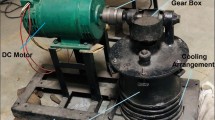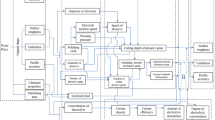Abstract
Magnetic abrasive polishing (MAP) is an advanced machining process that can produce smoother surfaces in many material types. The present study conducted an experimental assessment of MAP for a newly developed, non-ferrous and aluminum-based composite material. A permanent magnet was installed under the workpiece to enhance its magnetic flux density, which had proved insufficient for effective MAP. The success of the permanent magnet in improving the surface roughness of the non-ferrous material was verified.
Similar content being viewed by others
References
B. A. Zai, M. K. Park, H. S. Choi, H. Mehboob and R. Ali, Effect of moisture absorption on damping and dynamic stiffness of carbon fiber/epoxy composites, Journal of Mechanical Science and Technology, 23(11) (2009) 2998–3004.
D. K. Singh, V. K. Jain, V. Raghuram, R. Komanduri, Analysis of surface texture generated by a flexible magnetic abrasive brush, Wear, 259(7–12) (2005) 1254–1261.
A. Pramanik, L. C. Zhang and J. A. Arsecularatne, Machining of metal matrix composites: Effect of ceramic particles on residual stress, surface roughness and chip formation, International Journal of Machine Tools and Manufacture, 48(15) (2008) 1613–1625.
J. S. Kwak and Y. S. Kim, Mechanical properties and grinding performance on aluminum-based metal matrix composites, Journal of Materials Processing Technology, 201(1–3) (2008) 596–600.
T. T. Do and D. J. Lee, Analysis of tensile properties for composites with wrinkled fabric, Journal of Mechanical Science and Technology, 24(2) (2010) 471–479.
D. S. Han, I. B. Park, M. H. Kim, B. J. Noh, W. S. Kim and J. M. Lee, The effects of glass fiber reinforcement on the mechanical behavior of polyurethane foam, Journal of Mechanical Science and Technology, 24(1) (2010) 263–266.
J. C. Rubio, A. M. Abrao, P. E. Faria, A. E. Correia and J. P. Davim, Effects of high speed in the drilling of glass fiber reinforced plastic: evaluation of the delamination factor, International Journal of Machine Tools and Manufacture, 48(6) (2008) 715–720.
F. Muller and J. Monaghan, Non-conventional machining of particle reinforced metal matrix composite, International Journal of Machine Tools and Manufacture, 40(9) (2000) 1351–1366.
G. W. Chang, B. W. Yan and R. T. Hsu, Study on cylindrical magnetic abrasive finishing using unbonded magnetic abrasive, International Journal of Machine Tools and Manufacture, 42(5) (2002) 575–583.
T. Mori, K. Hirota and Y. Kawashima, Clarification of magnetic abrasive finishing mechanism, Journal of Materials Processing Technology, 132–144(1) (2003) 682–686.
A. Cetin and A. Kalkanli, Effect of solidification rate on spatial distribution of SiC particles in A356 alloy composites, Journal of Materials Processing Technology, 205(1–3) (2008) 1–8.
S. Kannan and H. A. Kishawy, Surface characteristics of machined aluminum metal matrix composites, International Journal of Machine Tools and Manufacture, 46(15) (2006) 2017–2025.
Author information
Authors and Affiliations
Corresponding author
Additional information
This paper was recommended for publication in revised form by Associate Editor Dae-Eun Kim
Tae-Wan Kim, Ph.D. and professor, is working in the Department of Mechanical Engineering at Pukyong National University, Korea. His research interests are tribology, contact mechanics, struture analysis and biomimetic engineering.
Dae-Min Kang, Ph.D. and professor, is working in the Department of Mechanical Engineering at Pukyong National University, Korea. He is an internationally well known expert in sheet metal forging, creep fracture and friction welding for magnesium alloys.
Jae-Seob Kwak, Ph.D., is a professor working in the Department of Mechanical Engineering at Pukyong National University, Korea. His research interests are grinding, micromachining, magnetic abrasive polishing and development of process optimization technologies.
Rights and permissions
About this article
Cite this article
Kim, TW., Kang, DM. & Kwak, JS. Application of magnetic abrasive polishing to composite materials. J Mech Sci Technol 24, 1029–1034 (2010). https://doi.org/10.1007/s12206-010-0323-6
Received:
Revised:
Accepted:
Published:
Issue Date:
DOI: https://doi.org/10.1007/s12206-010-0323-6




